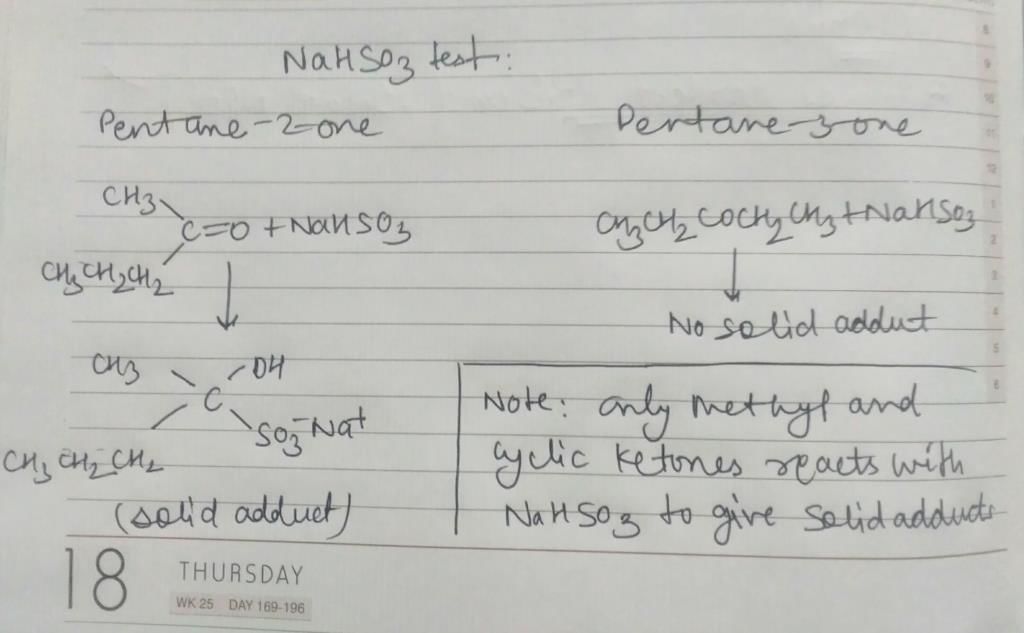NEET Exam > NEET Questions > How can NaSO3H be used to distinguish 3 penta...
Start Learning for Free
How can NaSO3H be used to distinguish 3 pentanone and 2 pentanone ?reaction?
Most Upvoted Answer
How can NaSO3H be used to distinguish 3 pentanone and 2 pentanone ?rea...

Community Answer
How can NaSO3H be used to distinguish 3 pentanone and 2 pentanone ?rea...
Introduction:
NaSO3H, also known as sodium bisulfite, can be used as a reagent to distinguish between 3-pentanone and 2-pentanone. This is because the two compounds have different reactivities towards NaSO3H, leading to the formation of different products.
Reaction:
When NaSO3H is added to 3-pentanone, it undergoes a reaction known as a nucleophilic addition. This reaction involves the addition of the bisulfite ion (HSO3-) to the carbonyl group of the ketone, forming a stable addition product.
In contrast, when NaSO3H is added to 2-pentanone, it undergoes a reaction known as an enolization. This reaction involves the formation of an enol intermediate, which then reacts with the bisulfite ion to form a different product.
Distinguishing 3-pentanone and 2-pentanone:
By comparing the products formed from the reactions of NaSO3H with 3-pentanone and 2-pentanone, it is possible to distinguish between the two ketones.
If the product obtained from the reaction with NaSO3H is a stable addition product, it indicates that the ketone is 3-pentanone. On the other hand, if the product obtained is an enol-bisulfite product, it indicates that the ketone is 2-pentanone.
Conclusion:
NaSO3H can be used as a reagent to distinguish between 3-pentanone and 2-pentanone based on their different reactivities towards the reagent. This method is useful in organic chemistry for identifying and characterizing different compounds.
NaSO3H, also known as sodium bisulfite, can be used as a reagent to distinguish between 3-pentanone and 2-pentanone. This is because the two compounds have different reactivities towards NaSO3H, leading to the formation of different products.
Reaction:
When NaSO3H is added to 3-pentanone, it undergoes a reaction known as a nucleophilic addition. This reaction involves the addition of the bisulfite ion (HSO3-) to the carbonyl group of the ketone, forming a stable addition product.
In contrast, when NaSO3H is added to 2-pentanone, it undergoes a reaction known as an enolization. This reaction involves the formation of an enol intermediate, which then reacts with the bisulfite ion to form a different product.
Distinguishing 3-pentanone and 2-pentanone:
By comparing the products formed from the reactions of NaSO3H with 3-pentanone and 2-pentanone, it is possible to distinguish between the two ketones.
If the product obtained from the reaction with NaSO3H is a stable addition product, it indicates that the ketone is 3-pentanone. On the other hand, if the product obtained is an enol-bisulfite product, it indicates that the ketone is 2-pentanone.
Conclusion:
NaSO3H can be used as a reagent to distinguish between 3-pentanone and 2-pentanone based on their different reactivities towards the reagent. This method is useful in organic chemistry for identifying and characterizing different compounds.
Attention NEET Students!
To make sure you are not studying endlessly, EduRev has designed NEET study material, with Structured Courses, Videos, & Test Series. Plus get personalized analysis, doubt solving and improvement plans to achieve a great score in NEET.

|
Explore Courses for NEET exam
|

|
Similar NEET Doubts
How can NaSO3H be used to distinguish 3 pentanone and 2 pentanone ?reaction?
Question Description
How can NaSO3H be used to distinguish 3 pentanone and 2 pentanone ?reaction? for NEET 2024 is part of NEET preparation. The Question and answers have been prepared according to the NEET exam syllabus. Information about How can NaSO3H be used to distinguish 3 pentanone and 2 pentanone ?reaction? covers all topics & solutions for NEET 2024 Exam. Find important definitions, questions, meanings, examples, exercises and tests below for How can NaSO3H be used to distinguish 3 pentanone and 2 pentanone ?reaction?.
How can NaSO3H be used to distinguish 3 pentanone and 2 pentanone ?reaction? for NEET 2024 is part of NEET preparation. The Question and answers have been prepared according to the NEET exam syllabus. Information about How can NaSO3H be used to distinguish 3 pentanone and 2 pentanone ?reaction? covers all topics & solutions for NEET 2024 Exam. Find important definitions, questions, meanings, examples, exercises and tests below for How can NaSO3H be used to distinguish 3 pentanone and 2 pentanone ?reaction?.
Solutions for How can NaSO3H be used to distinguish 3 pentanone and 2 pentanone ?reaction? in English & in Hindi are available as part of our courses for NEET.
Download more important topics, notes, lectures and mock test series for NEET Exam by signing up for free.
Here you can find the meaning of How can NaSO3H be used to distinguish 3 pentanone and 2 pentanone ?reaction? defined & explained in the simplest way possible. Besides giving the explanation of
How can NaSO3H be used to distinguish 3 pentanone and 2 pentanone ?reaction?, a detailed solution for How can NaSO3H be used to distinguish 3 pentanone and 2 pentanone ?reaction? has been provided alongside types of How can NaSO3H be used to distinguish 3 pentanone and 2 pentanone ?reaction? theory, EduRev gives you an
ample number of questions to practice How can NaSO3H be used to distinguish 3 pentanone and 2 pentanone ?reaction? tests, examples and also practice NEET tests.

|
Explore Courses for NEET exam
|

|
Suggested Free Tests
Signup for Free!
Signup to see your scores go up within 7 days! Learn & Practice with 1000+ FREE Notes, Videos & Tests.

























